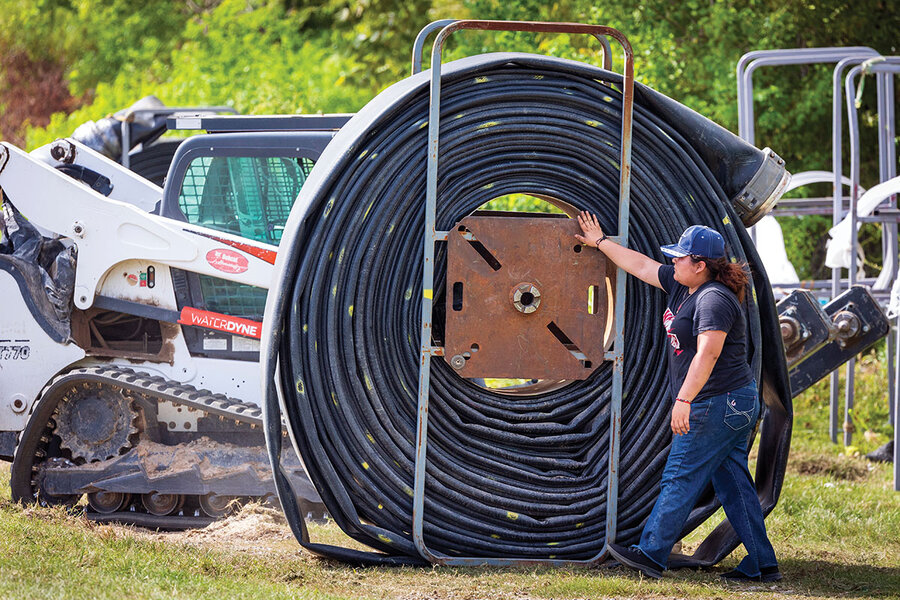Saltwater influx tests communities near Mississippi’s mouth
Loading...
Salt water from the Gulf of Mexico is steadily creeping up the Mississippi River in Louisiana, prompting urgent efforts by officials to maintain tap water quality for people in the region.
The reason: Droughts across the Midwest have slowed the river’s flow, and as a result, a “wedge” of higher-salinity water is encroaching farther upstream. The river, in turn, is a primary source of water for many parts of the state, including New Orleans. With some experts attributing the problem partly to climate change, many Louisianians worry about their future water supply.
“Long term, we can’t continue like this,” says Stephen Murphy, an assistant professor of environmental health sciences at Tulane University. “We can’t keep putting Band-Aids on this.”
Why We Wrote This
An intrusion of salt water creates challenges for water treatment plants along the Mississippi River – and raises longer-term questions about how to manage a changing waterway.
What is the problem, and is climate change a factor?
For the second year in a row, droughts in Mississippi basin states such as Missouri, Nebraska, and Kansas have weakened the river’s flow. In essence, that creates room for salt water to flow upstream in Louisiana, where the river bottom is lower than the Gulf of Mexico’s surface level. A wedge of salt water, mostly near the bottom of the riverbed due to its density, is traveling north; it reached 64 miles upstream by mid-October.
Other contributors besides climate change can affect saltwater intrusion, such as how the river is dredged, seasonal variability, and other weather patterns such as El Niño. And instances of saltwater intrusion have occurred in Louisiana before.
But after back-to-back years of unusually low flow in the river, the world’s hottest summer to date, and abnormal precipitation across America, scientists say climate change is likely playing a role.
“If I had to put my money on it, I would say climate change is part of this,” says Nicole Gasparini, an earth and environmental sciences professor at Tulane University.
The river’s flow has recently been about 170,000 cubic feet per second, barely twice the lowest ever recorded. (Flows can exceed 2 million cubic feet per second at their strongest.)
How long might it last?
State officials suggest saltwater intrusion could last through next year.
“The bottom line is there’s not a whole lot of relief in sight,” at least not soon, says Barry Keim, a climatologist at Louisiana State University. The roughly 10 inches of precipitation across the Mississippi and Ohio river valleys needed to push the wedge downriver could take months.
What are the effects on people?
In addition to affecting drinking water, saltwater intrusion can corrode pipes and pose a problem for agriculture, as irrigation water for many farmers comes from the Mississippi. The shipping industry – including barges laden with grain – is also affected by narrowing channels for navigation.
Plaquemines Parish, which is located south of New Orleans and is the site of the Mississippi River delta basin, issued a drinking water advisory in June. Officials supplied bottled water until the advisory was lifted on Oct. 18. As of Sept. 27, President Joe Biden has declared a state of emergency covering four Louisiana parishes. His statement said water supplies for 20% of the state’s population are at risk.
While the saltwater wedge has not yet reached New Orleans, the state’s most populous city, the Army Corps of Engineers has been tracking the risk that this could occur. The Corps predicts the wedge has the potential to move another 50 miles upstream – past New Orleans. But recent efforts by the Corps to slow the saltwater wedge, coupled with slightly stronger river flows than expected, have reduced the immediate threat.
How are officials trying to help?
The Corps has been sending fresh water by barge to water treatment facilities along the river to reduce tap water salinity. Longer term, building a pipeline that starts a few miles upriver could be one way to safeguard key water treatment facilities.
In July, the Corps built a sill in the Mississippi at river mile 64, which brought the bottom of the river up nearly 35 feet, and Corps engineers are currently working to expand the sill. Sills act as underwater levees that can block or slow the saltwater wedge from moving upstream. A “notch” in the sill allows oceangoing vessels to pass. The Corps has also built sills in Louisiana in 1988, 1999, 2012, and 2022.
“The magic number we kind of look for in the river is a flow rate of 300,000 cubic feet per second,” says Matt Roe, a spokesperson for the Corps. “And that’s enough to push the wedge further back out of the river. But also when the river hits above that rate, it does erode out and wash the sill away.”







